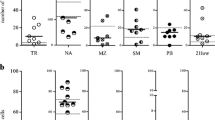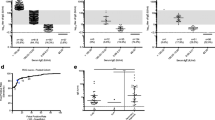Abstract
The Ig class and IgG subclasses of anti-Treponema pallidum antibodies in human serum were quantified using solid-phase enzyme-linked immunosorbent assays. Development of these assays with monoclonal antibodies, each specific for a human immunoglobulin class or IgG subclass, provided quantitative data concerning the major antibody specificities. In patients with primary syphilis, anti-T. pallidum activity was limited almost exclusively to IgG1 and IgM. Coordinate, restricted expression of IgG1 and IgG3 responses inT. pallidum-specific assays was observed with sera from patients with active secondary syphilis. IgG1 and IgG3 accounted for roughly 53 and 43% of the total anti-treponemal IgG antibody activity, respectively. While IgM antibody levels were elevated in the patients with secondary syphilis, IgG2 and IgG4 levels, if present at all, represented less than 10 and 2% of the total IgG activity, respectively. Ig in sera from patients who had been treated adequately for secondary syphilis were restricted almost entirely to IgG3 and IgG1. Considering the low level of IgG3 in serum, disproportionately high percentages of antitreponemal antibodies were found in this subclass during and after treatment for secondary syphilis. The restricted, coexpression of the IgG1 and IgG3 isotypes may reflect the close genetic linkage of the γ1 and γ3 genes and possibly the impact of immunoregulatory mechanisms in response to the induction and expression of autoantibodies which arise during the course of secondary syphilis.
Similar content being viewed by others
References
Turner TB, Hollander DH: Biology of the treponematoses. WHO Monogr Ser 35:3–128, 1957
Clark EG, Danbolt N: The Olso study of the natural course of untreated syphilis: An epidemiologic investigation based on a re-study of the Boeck-Bruusgaard material. Med Clin N Am 48:613–623, 1964
Ingall D, Musher DM: Congenital syphilis.In Infectious Diseases of the Fetus and Newborn Infant, 2nd ed., JS Remington, JD Klein (eds). Philadelphia, Saunders, 1983, pp 335–374
Baughn RE, McNeely MC, Jorizzo JL, Musher DM: Characterization of the antigenic determinants and host components in immune complexes from patients with secondary syphilis. J Immunol 136:1406–1414, 1986
Muller F: Specific immunoglobulin M and G antibodies in the rapid diagnosis of human treponemal infections. Diag Immunol 4: 1–9, 1986
Uhr JE, Moller G: Regulatory effect of antibody on the immune response. Adv Immunochem 8:81–127, 1968
U.S. Department of Health, Education and Welfare: Manual of Tests for Syphilis, Publ No 411. Washington, DC, U.S. Government Printing Office, 1969
Tight RR, White AC: Quantitative microhaemagglutination assay forTreponemal pallidum antibodies in experimental syphilis. Br J Vener Dis 56:291–296, 1980
Coleman RM, Nahmias AJ, Williams SC, Phillips DJ, Black CM, Reimer CB: IgG subclass antibodies to Herpes simplex virus. J Infect Dis 151:929–936, 1985
Rubin RL, Tang F, Lucas AH, Spiegelberg HL, Tan EM: IgG subclasses of anti-tetanus toxoid antibodies in adults and newborn normal subjects and in patients with systemic lupus erythematosus. Sjogren's syndrome, and drug-induced autoimmunity. J Immunol 137:2522–2527, 1986
Rubin RL, Tang F, Chan EKL, Pollard KM, Tsay G, Tan EM: IgG subclasses of autoantibodies in systemic lupus erythematosus, Sjogren's syndrome, and drug-induced auto-immunity. J Immunol 137:2528–2534, 1986
Veldkamp J, Visser M: Application of the enzyme-linked immunosorbent assay (ELISA) in the serodiagnosis of syphilis. Br J Vener Dis 51:227–231, 1975
Pedersen NS, Petersen CS, Axelsen NJ: Enzyme-linked immunosorbent assay for detection of immunoglobulin M antibody against the Reiter treponeme flagellum in syphilis. J Clin Microbiol 16:608–614, 1982
Pedersen NS, Petersen CS, Vejtorp M, Axelson NH: Serodiagnosis of syphilis by an enzyme-linked immunosorbent assay for IgG antibodies against the Reiter treponeme flagellum. Scand J Immunol 15(4):341–348, 1982
Pope V, Hunter EF, Feeley JC: Evaluation of the microenzyme-linked immunosorbent assay withTreponema pallidum antigen. J Clin Microbiol 15:630–634, 1982
Farshy CE, Hunter EF, Larsen SA, Cerny EH: Double-conjugate enzyme-linked immunosorbent assay for immunoglobulins G and M againstTreponema pallidum. J Clin Micro 20:1109–1113, 1984
Lee JB, Farshy CE, Hunter EF, Hambie EA, Wobig GH, Larsen SA: Detection of immunoglobulin M in cerebrospinal fluid from syphilis patients by enzyme-linked immunosorbent assay. J Clin Microbiol 24:736–740, 1986
Olmsted JB: Affinity purification of antibodies from diazotized paper blots of heterogenous protein samples. J Biol Chem 256:11955–11957, 1981
Baughn RE, Musher DM: Radioimmunoassays for the detection of antibodies to treponemal polypeptide antigens in serum. J Clin Microbiol 21:922–929, 1985
Baughn RE, Musher DM: Isolation and preliminary characterization of circulating immune complexes from rabbits with experimental syphilis. Infect Immun 42:579–584, 1983
Baughn RE, Adams CB, Musher DM: Circulating immune complexes in experimental syphilis: Identification of treponemal antigens and specific antibodies to treponemal antigens in isolated complexes. Infect Immun 42:585–593, 1983
Laemmli JK: Cleavage of structural proteins during the assembly of the head of bacteriophage T4. Nature 277:680–685, 1970
Towbin H, Staehelin T, Gordon J: Electrophoretic transfer of proteins form polyacrylamide gels to nitrocellulose sheets: Procedure and some applications. Proc Natl Acad Sci USA 76:4350–4354, 1979
Batteiger B, Newhall WJ, Jones RB: The use of Tween 20 as a blocking agent in the immunological detection of proteins transferred to nitrocellulose membranes. J Immunol Methods 55:297–307, 1982
Statistical Analysis System Institute: SAS User's Guide, Cary, NC, Statistical Analysis System Institute, 1982, pp 217–221
Morrison-Plummer J, Alderete JF, Baseman JB: Enzymelinked immunosorbent assay for the detection of serum antibody to outer membrane proteins ofTreponema pallidum. Br J Vener Dis 59:75–79, 1983
Muller F, Moskophidis M: Evaluation of an enzyme immunoassay for IgM antibodies toTreponema pallidum in syphilis in man. Br J Vener Dis 60:288–292, 1984
Atwood WG, Miller JL: Fluorescent treponemal antibodies in fractionated syphilis sera. Arch Dermatol 100:763–769, 1969
Cohen IR, Norins LC, Julian AJ: Comparison between, and effectciveness of, IgG and IgM antibodies in indirect fluorescent antibody and other tests. J Immunol 98:143–149, 1967
Norris SJ, Alderete JF, Baker-Zander SA, Baseman JB, Bassfor PJ, Baughn RE, Hanff PA, Larsen SA, Lukehart SA, Moskophidis MA, Muller F, Norgard MV, Penn CW, Stamm LV, van Embden JD, Wicher K: Identity ofTreponema pallidum polypeptides: Correlation of sodium dodecyl sulfatepolyacrylamide gel electrophoresis results form different laboratories. Electrophoresis 8:77–92, 1987
Baker-Zander SA, Hook EW III, Bonin P, Handsfield HH, Lukehart SA: Antigens ofTreponema pallidum recognized by IgG and IgM antibodies during syphilis in humans. J Infect Dis 151:264–272, 1985
Baker-Zander SA, Roddy RE, Handsfield H, Lukehart SA: IgG and IgM antibody reactivity to antigens ofTreponema pallidum after treatment of syphilis. Sex Transmitt Dis 13:214–220, 1986
Hunter EF, Maddison SE, Larsen SA, Felker MB, Feeley JC: Immunoglobulin specificity for the fluorescent treponemal antibody absorption test conjugate. J Microbiol 4:338–342, 1976
Julian AJ, Logan LC, Nurins LC: Early syphilis immunoglobulins reactive in immunofluorescence and other serologic tests. J Immunol 102:1250–1259, 1969
Julian AJ, Logan LC, Norins LC, Scott AT: Latent syphilis immunoglobulins reactive in immunofluorescence and other serological tests. Infect Immun 3:559–561, 1969
Kiraly K, Backhausz R, Jobbagy A, Lagos J, Kovas L: Fluorescent treponemal antibody test with antigen and immune sera of different specificity. Acta Derm Venereol 48:362–369, 1968
Brown WJ, Kuhn USG, Tolliver EA, Norins LC: Experimental syphilis in the chimpanzee. Immunoglobulin class of early antibodies reactive withTreponema pallidum. J Vener Dis 46:198–200, 1970
O'Neill P, Nicol SC: IgM class antitreponemal antibody in treated and untreated syphilis. Br J Vener Dis 48:460–463, 1972
Shannon R, Booth SD: The pattern of immunological responses at various stages of syphilis. Br J Vener Dis 53:281–286, 1977
Wilkinson AF, Rodin P: IgM-FTA test in syphilis in adults. Its relation to clinical findings. Br J Vener Dis 52:219–223, 1976
van der Sluis JJ, van Reede EC, Boer M: Immunoglobulin G subclasses of fluorescent anti-Treponema pailidum antibodies: Evidence for sequential development of specific anti-T. pallidum immunoglobulin G response in patients with early syphilis. J Clin Micro 24:418–423, 1986
Puritz EM, Thompson JA Jr., Diereberg F, Kraus SJ, Young WJ: IgG subclasses of fluorescent treponemal antibodies: Correlation with complement fixation and clinical stage. Clin Immunol Immunopathol 4:352–361, 1975
Goodman JW: Immunoglobulins I: Structure and function.In Basic and Clinical Immunology, 5th ed, DP Stites, JD Stobo, HH Fundenberg, JV Wells (eds). Los Altos, CA, Lange Medical, pp 30–42
Shackelford PG, Granoff DM, Nelson SJ, Scott MG, Smith DS, Nahm MH: Subclass distribution of human antibodies toHaemophilus influenzae type b capsular polysaccharide. J Immunol 138:587–592, 1987
Flanagan JG, Rabbitts TH: Arrangement of human immunoglobulin heavy chain constant region genes implies evolutionary duplication of a segment containing γ, ε and α genes. Nature 300:709–713, 1982
Iskander R, Das PK, Aalberse RC: IgG4 antibodies in Egyptian patients with schistosomiasis. Int Arch Allergy Appl Immunol 66:200–207, 1981
Aalberse RC, van der Gaag R, van Leeuwen J: Sereologic aspects of IgG4 antibodies. J Immunol 130:722–726, 1983
Ottesen EA, Skvaril F, Tripathy SP, Poindexter RW, Hussain R: Prominence of IgG4 in the IgG antibody resonse to human filariasis. J Immunol 134:2707–2712, 1985
Natvig JB, Kunkel HG, Litwin SD: Genetic markers of the heavy chain subgroups of human IgG. Cold Spring Harbor Symp Quant Biol 32:173–191, 1967
Yount WJ, Dorner MM, Kunkel HG, Kabat EA: Studies on human antibodies. VI. Selective variations in subgroup composition and genetic markers. J Exp Med 127:633–646, 1968
Carrel S, Morell A, Skvaril F, Barandun S: Human tetanus antibodies; isolation and characterization with special reference to the IgG subclasses. FEBS Lett 19:305–308, 1972
Stevens R, Dichek D, Keld B, Heiner D: IgG1 is the predominant subclass of in vivo and in vitro produced antitetanus toxoid antibodies and also serves as the membrane IgG molecule for delivering inhibitory signals to anti-tetanus toxoid antibody-producing B cells. J Clin Immunol 3:65–76, 1983
Van der Giessen M, Groenboer-Kempers O: The subclass of human IgG antibodies against tetanus toxoid. Clin Exp Immunol 25:117–121, 1976
Eisenberg RA, Dyer K, Craven SY, Fuller CR, Young WJ: Subclass restriction and polyclonality of the systemic lupus erythematosus marker antibody anti-Sm. J Clin Invest 75:1270–1278, 1985
Puritz EM, Young WJ, Newell M, Utsinger PD: Immunoglobulin classes and IgG subclasses of human antinuclear antibodies: A correlation of complement fixation and the nephritis of systemic lupus erythematosus. Clin Immunol Immunopathol 2:98–113, 1973
Schur PH, Monroe M, Rothfield N: The gamma-G subclass of antinuclear and antinucleic acid antibodies. Arth Rheum 15:174–181, 1972
Sontheimer RD, Gilliam JN: DNA antibody class, subclass, and complement fixation in systemic lupus erythematosus with and without nephritis. Clin Immunol Immunopathol 10:459–466, 1978
Yount WJ, Dyer K, Fuller CR: Distribution of double-stranded DNS (dsDNA) antibodies in systemic lupus erythematosus (SLE); Restriction to IgM, IgG1 and IgG3. Arth Rheum 26:S73-S81, 1983
Zoualf M, Jefferis R, Eyquem A: IgG subclass distribution of autoantibodies to DNA and to nuclear ribonucleoproteins in autoimmune diseases. Immunology 51:595–600, 1984
Author information
Authors and Affiliations
Rights and permissions
About this article
Cite this article
Baughn, R.E., Jorizzo, J.L., Adams, C.B. et al. Ig class and IgG subclass responses toTreponema pallidum in patients with syphilis. J Clin Immunol 8, 128–139 (1988). https://doi.org/10.1007/BF00917901
Accepted:
Issue Date:
DOI: https://doi.org/10.1007/BF00917901




